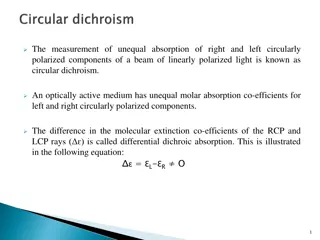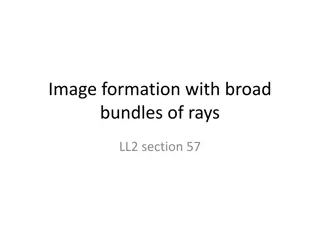
Geometrical Representation in Optical Mineralogy: Indicatrix Types and Construction
Explore the concept of geometrical representation through indicatrix in optical mineralogy, including types such as isotropic, uniaxial, and biaxial, along with the construction process. Discover how the index of refraction varies, dependence on wavelength, viewing isotropic minerals, and unique characteristics like high-order axes in crystals.
Download Presentation

Please find below an Image/Link to download the presentation.
The content on the website is provided AS IS for your information and personal use only. It may not be sold, licensed, or shared on other websites without obtaining consent from the author. If you encounter any issues during the download, it is possible that the publisher has removed the file from their server.
You are allowed to download the files provided on this website for personal or commercial use, subject to the condition that they are used lawfully. All files are the property of their respective owners.
The content on the website is provided AS IS for your information and personal use only. It may not be sold, licensed, or shared on other websites without obtaining consent from the author.
E N D
Presentation Transcript
Optical Mineralogy LECTURE -8 , M.Sc. ( Geology) I Semester NIRANJAN MOHANTY DEPARTMENT OF GEOLOGY, MLS UNIVERSITY UDAIPUR-313001 (RAJASTHAN) E-mail: niranjan@mlsu.ac.in
Geometrical Representation The geometrical representation is called an indicatrix The idea of a geometrical representation of the variance of the index of refraction goes back to Sir Lazarus Fletcher (1854-1921) in The Optical Indicatrix and the Transmission of Light in Crystals (London, 1892) 2
Types of Indicatrix There are three general types of indicatrix These are Isotropic Uniaxial Biaxial 3
Constructing the Indicatrix A vector, equal in magnitude to the index of refraction, can be assumed to originate at some origin The direction is arbitrary The heads of an infinite collection of such vectors, all pointing outward from the origin, would describe the geometrical figure called the indicatrix 4
Isotropic Indicatrix The index of refraction is equal in all directions In the case of an isotropic substance, the indicatrix is a perfect sphere 5
Dependence on Wavelength The magnitude of the vector, representing the index of refraction, will change depending on the wavelength of the light Thus, the size of the sphere will change, but the isotropic indicatrix remains a sphere 6
Viewing Isotropic Minerals An isotropic crystal viewed in crossed nicols always remains in extinction 7
High-Order Axes Crystals of the hexagonal and tetragonal systems have a unique high order axis (6 or 3 fold, hexagonal; 4-fold, tetragonal). It was discovered that rhombohedral calcite crystals give rise to not one but two refracted rays when light is incident on the surface 8
Explanation of Double Refraction Can be explained using the indicatrix theory if it is assumed that the index of refraction varies in different directions 10
Uniaxial Crystals For a uniaxial crystal it is found that the indicatrix is an ellipsoid, rather than a sphere Light propagating perpendicular to the c-axis direction (light vibrates parallel to the c-axis) will experience an index of refraction called (epsilon) Light which vibrates perpendicular to the c-axis will experience, in any plane, an index of refraction called (omega) 11
Uniaxial Positive Ellipsoid is prolate, like a football EGO is POSITIVE (Epsilon Greater than Omega) 14
Uniaxial Negative Ellipsoid is oblate, like a hamburger 15
Optic Axis Optic axis of a uniaxial crystal is the high-order symmetry axis 16
Random Sections The principle axis will be and , where is intermediate to and in value 18
Calculation of is the angle between the plane which cuts the ellipsoid and the c-axis 19
Wave Normal 20
Wave Front Green lines show the wave front 21
Quartz Uniaxial Figures Diagram shows the variation of the indices of refraction with viewing direction in quartz 22
Lack of Symmetry Restrictions Crystals which belong to the orthorhombic, monoclinic, or triclinic systems possess no axis higher than 2-fold There is nothing in the crystal symmetry which requires the index of refraction in the a-b plane to have a single value A2 fold takes a into a, b into b Whereas A4 fold takes a into b, etc. 23
Biaxial Crystals Crystals which belong to the orthorhombic, monoclinic and triclinic systems are known as biaxial crystals The index of refraction is triaxial ellipsoid 24
Optical Axes in Biaxial Crystals The direction of the fastest ray is called X, and the slowest is called Z These directions are perpendicular A third direction, perpendicular to XZ plane, is called Y 26
Biaxial Indices of Refraction is the lowest (X - direction) is intermediate (Y - direction), is highest (Z - direction) These correspond to crystal directions but not in a particular order 27
Birefringence Numerical difference - is called the birefringence This value will be experienced by a ray traveling perpendicular to the X-Z plane Note that is not the average of & but merely a value in between these two 28
Optic Axial Plane This plane, often abbreviated OAP, shows the maximum birefringence 29
Circular Sections 33
Vzand , , and + + ( ( )( )( ) ) Vz= cos 37
2V and 2E 38





















